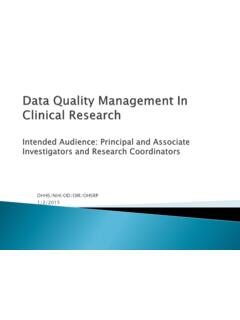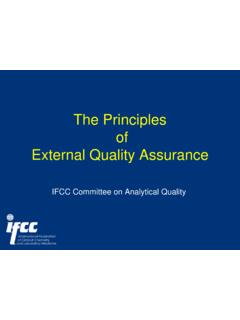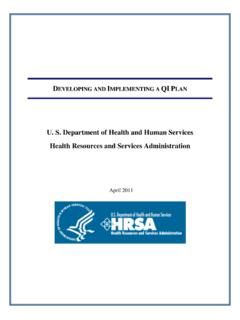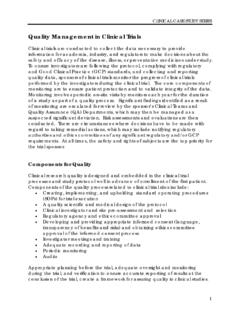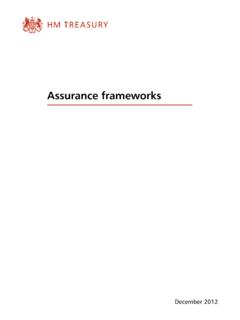Transcription of A GUIDE TO DEVELOPING AND ASSESSING A QUALITY PLAN
1 A GUIDE TO DEVELOPING AND ASSESSING A QUALITY PLAN For Healthcare Organizations An Initiative of The Collaborative for Excellence in Healthcare QUALITY Version 1 February 2012 1 PREFACE There has been increased activity recently focused on improving the QUALITY of care in healthcare organizations across Canada. This activity has involved DEVELOPING more comprehensive QUALITY Plans and reporting mechanisms, as well as ensuring alignment of these Plans throughout an organization - from the Board to the ward level. In addition to the work undertaken by individual healthcare organizations, governments have increased their emphasis on Board accountability and mandatory public reporting on QUALITY performance.
2 National organizations and provincial QUALITY councils have played important roles in assisting healthcare organizations to respond to these developments. The Canadian Patient Safety Institute and the Canadian Health Services Research Foundation have worked together to provide tools and reference materials. Accreditation Canada released updated governance standards and an updated Governance Functioning Tool (for the Board s role in QUALITY and safety). The Canadian Institute for Health Information has created a hospital report card which contains performance information. A number of provincial QUALITY councils now issue regular reports on QUALITY performance for the organizations in their jurisdictions.
3 In 2009, eleven academic healthcare organizations across Canada came together to create the Collaborative for Excellence in Healthcare QUALITY (CEHQ). The broad goal of this initiative is to develop a framework and set of QUALITY measures that can be used to benchmark performance in academic health sciences centres specifically, and to learn from each other on the best ways to attain higher levels of performance. In December 2010, a review of the QUALITY Plans of the eleven CEHQ organizations indicated a great deal of variability in the content and format of these Plans. A further literature review indicated that there were limited standards for DEVELOPING QUALITY Plans in healthcare.
4 These findings led to the creation of this project as part of the overall CEHQ initiative. The objective of this project was to assist organizations in the development of an effective QUALITY Plan by: DEVELOPING guidelines for QUALITY Plans that will create a framework for action and high performance; Producing aids and tools that can be adapted and used in varied situations and environments; and Facilitating the sharing of sample Plans from various organizations. Our aim was to produce a practical GUIDE that will be useful in all types of healthcare organizations in DEVELOPING effective QUALITY Plans and reporting mechanisms. We are hopeful that this GUIDE will play an important role in improving QUALITY outcomes across the country.
5 The individuals who assisted with the project are listed on the following page. We would like to thank them for their contribution to the project. Laurie Hicks James Nininger, PhD Project Co-Chair Project Co-Chair Board Member, Chair, Community for Excellence University Health Network in Health Governance 2 ACKNOWLEDGEMENTS Representatives of all eleven CEHQ organizations, as well as officials from the supporting organizations were invited to participate in the project. They did this by participating in a series of teleconferences wherein they shared their experiences and ideas as well as by critiquing various drafts of the report.
6 CEHQ Project Team Laurie Hicks (Co-Chair), Board Member, University Health Network James Nininger (Co-Chair), Chair, Community for Excellence in Health Governance Chantal Backman, Senior Project Manager, Collaborative for Excellence in Healthcare QUALITY Alan Forster, Scientific Director, Performance Measurement, The Ottawa Hospital Lisa Freeman, Acting Senior Project Manager, Collaborative for Excellence in Healthcare QUALITY Linda Hunter, Director, QUALITY , Patient Safety and Patient Flow, The Ottawa Hospital Alycia White-Brown, Project Manager, Collaborative for Excellence in Healthcare QUALITY Representatives of Participating and Sponsor Organizations Jonathan Mitchell, Manager, Policy and Research, Accreditation Canada Kristen Edmiston.
7 Director of Division Projects & Planning QUALITY & Healthcare Improvement, Alberta Health Services Catherine Gaulton, Vice-President Performance Excellence & General Counsel, Capital District Health Authority Gail Blackmore, Director Performance Excellence, Capital District Health Authority Linda Hubert, Directrice de la qualit , Centre Hospitalier universitaire de Sherbrooke Renald Lemieux, Directeur de l' valuation des technologies, Centre Hospitalier universitaire de Sherbrooke Jocelyne Frenette, Conseill re cadre la gestion de la qualit , Centre Hospitalier universitaire de Sherbrooke Wayne Miller, Vice-President, QUALITY , Patient Safety and Planning, Eastern Regional Health Authority Danielle Lemay, Directrice associ e, Gestion de la qualit et des risques, McGill University Health Centre Candice Bryden, Director, QUALITY Services, Saskatoon Health Region Patricia McKernan, Director of Risk Management and QUALITY Improvement, St.
8 Michael s Hospital Emily Musing, Patient Safety Officer, University Health Network Janet Joy, Director, Innovation Funds, Vancouver Coastal Health Authority Susan Morrow, Project Officer, Winnipeg Regional Health Authority For any questions or comments about this document, please contact Chantal Backman at 3 EXECUTIVE SUMMARY QUALITY and safety is now a recognized strategic imperative of healthcare organizations. To create long-term measurable and sustainable changes in QUALITY and safety, many healthcare providers are either at the early stages of DEVELOPING a QUALITY Plan, or are enhancing their current Plans to make them more effective. This GUIDE was created to assist both types of organizations.
9 The GUIDE is an undertaking of the Collaborative for Excellence in Healthcare QUALITY (CEHQ), which consists of eleven academic health science centres from across Canada, who have come together to improve the QUALITY of care and safety in their organizations. A review of the QUALITY Plans of the member organizations revealed a great deal of variability, and a literature review indicated a gap in the information available to GUIDE organizations in DEVELOPING or improving a QUALITY Plan. The focus on improved QUALITY and safety has been driven by a variety of organizations including QUALITY councils, national organizations, and provincial governments which have placed increased attention on mandatory reporting.
10 The CEHQ Working Group that developed this GUIDE suggests that the following areas be taken into account in DEVELOPING and using a QUALITY Plan. KEY PRINCIPLES A QUALITY Plan should be built based on nine key principles. It should be: clearly aligned to the strategic plan; tied to a QUALITY framework; have a natural progression from previous years Plan; be clear, easy to understand and interpret; have measurable goals and include targets; be based on resources available; evaluated on an annual basis; and be helpful in influencing permanent cultural change. Section 2 discusses the principles in further detail. ACCOUNTABILITIES The development, approval and implementation of the QUALITY Plan involves groups at various levels of the organization including: the Board of Directors, the Senior Executive Team, clinical leadership, and QUALITY officials.


